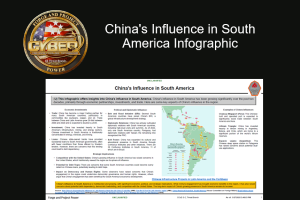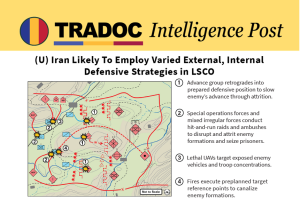Read the NEW TRADOC G2 Newsletter December 2020
By TRADOC
Distribution A: Approved for public release
File Size:
612 KB
File Type:
Page Count:
1
Share & Get The Message Out
12/11/2020|Artificial Intelligence, China, cyber, Electronic Warfare, Europe, Information Operations, Iran, military, NATO, North Korea, Operational Environment, Pakistan, Russia, security, technology, Terrorism, UAV, warfare
Related Products
The Army’s Training Environment Enabling Indo-Pacific Integrated Deterrence
Check out TRADOC G-2's contribution to Military Review, The Army's...
U.S. Adversaries’ Trilateral Naval Exercises Reflect Convenience, Not Convergence
This paper is the first in a new series that...
The Pacific Security Environment
TRADOC G-2 briefing on the "The Pacific Security Environment" presented...
Mexican Cartels EW and Cyber Capabilities Infographic
This infographic offers insights into Mexican Cartels EW and Cyber...
China’s Influence in South America Infographic
This infographic offers insights into China's influence in South America....
Iran Likely To Employ Varied External, Internal Defensive Strategies in LSCO
This intelligence post examines Iran’s forward defense and mosaic defense...
Ukraine’s Uncrewed Air and Ground Systems Teaming Marks a Watershed Moment
In December 2024, Ukraine’s 13th KHARTIIA Ukrainian National Guard Brigade,...












